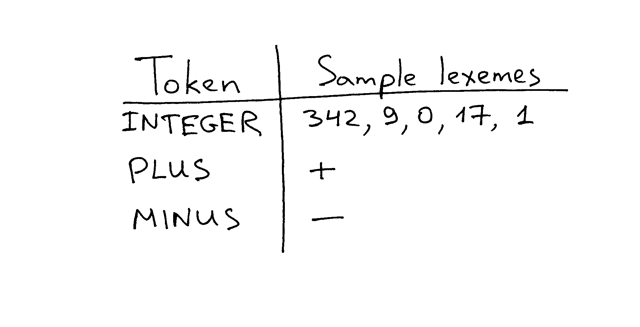实现一个简单的解释器(2)
译自:https://ruslanspivak.com/lsbasi-part2/
(已获作者授权)
在他们的著作《有效思维的五个要素》(The 5 Elements of Effective Thinking)中,Burger和Starbird分享了一个故事,讲述了他们如何观察国际知名的小号演奏家托尼·普洛(Tony Plog)为有成就的小号演奏家举办大师班。学生们首先演奏复杂的乐句,他们演奏得很好,但是随后他们被要求演奏非常基本、简单的音符时,与以前演奏的复杂乐句相比,这些音符听起来更幼稚(childish)。他们演奏完毕后,大师老师也演奏了相同的音符,但是当他演奏它们时,它们听起来并不幼稚,区别是惊人的。托尼解释说,掌握简单音符的演奏可以使人在更复杂的控制下演奏复杂的乐曲。该课程很明确:要建立真正的技巧,必须将重点放在掌握简单的基本思想上。
故事中的课程显然不仅适用于音乐,还适用于软件开发。这个故事很好地提醒了我们所有人,即使有时感觉就像是退后一步,也不要忘记深入研究简单,基本概念的重要性。精通所使用的工具或框架很重要,但了解其背后的原理也非常重要。正如Ralph Waldo Emerson所说:
“如果你只学习方法,那么你将被束缚在方法上。 但是,如果你学习了原理,就可以设计自己的方法。”
关于这一点,让我们再次深入了解解释器和编译器。
今天,我将向您展示第1部分中的计算器的新版本,该版本将能够:
1、在输入字符串中的处理任何地方的空格
2、处理输入中的多位数整数
3、减去两个整数(当前只能加整数)
这是可以执行上述所有操作的新版本计算器的源代码:
# Token types
# EOF (end-of-file) token is used to indicate that
# there is no more input left for lexical analysis
INTEGER, PLUS, MINUS, EOF = 'INTEGER', 'PLUS', 'MINUS', 'EOF'
class Token(object):
def __init__(self, type, value):
# token type: INTEGER, PLUS, MINUS, or EOF
self.type = type
# token value: non-negative integer value, '+', '-', or None
self.value = value
def __str__(self):
"""String representation of the class instance.
Examples:
Token(INTEGER, 3)
Token(PLUS '+')
"""
return 'Token({type}, {value})'.format(
type=self.type,
value=repr(self.value)
)
def __repr__(self):
return self.__str__()
class Interpreter(object):
def __init__(self, text):
# client string input, e.g. "3 + 5", "12 - 5", etc
self.text = text
# self.pos is an index into self.text
self.pos = 0
# current token instance
self.current_token = None
self.current_char = self.text[self.pos]
def error(self):
raise Exception('Error parsing input')
def advance(self):
"""Advance the 'pos' pointer and set the 'current_char' variable."""
self.pos += 1
if self.pos > len(self.text) - 1:
self.current_char = None # Indicates end of input
else:
self.current_char = self.text[self.pos]
def skip_whitespace(self):
while self.current_char is not None and self.current_char.isspace():
self.advance()
def integer(self):
"""Return a (multidigit) integer consumed from the input."""
result = ''
while self.current_char is not None and self.current_char.isdigit():
result += self.current_char
self.advance()
return int(result)
def get_next_token(self):
"""Lexical analyzer (also known as scanner or tokenizer)
This method is responsible for breaking a sentence
apart into tokens.
"""
while self.current_char is not None:
if self.current_char.isspace():
self.skip_whitespace()
continue
if self.current_char.isdigit():
return Token(INTEGER, self.integer())
if self.current_char == '+':
self.advance()
return Token(PLUS, '+')
if self.current_char == '-':
self.advance()
return Token(MINUS, '-')
self.error()
return Token(EOF, None)
def eat(self, token_type):
# compare the current token type with the passed token
# type and if they match then "eat" the current token
# and assign the next token to the self.current_token,
# otherwise raise an exception.
if self.current_token.type == token_type:
self.current_token = self.get_next_token()
else:
self.error()
def expr(self):
"""Parser / Interpreter
expr -> INTEGER PLUS INTEGER
expr -> INTEGER MINUS INTEGER
"""
# set current token to the first token taken from the input
self.current_token = self.get_next_token()
# we expect the current token to be an integer
left = self.current_token
self.eat(INTEGER)
# we expect the current token to be either a '+' or '-'
op = self.current_token
if op.type == PLUS:
self.eat(PLUS)
else:
self.eat(MINUS)
# we expect the current token to be an integer
right = self.current_token
self.eat(INTEGER)
# after the above call the self.current_token is set to
# EOF token
# at this point either the INTEGER PLUS INTEGER or
# the INTEGER MINUS INTEGER sequence of tokens
# has been successfully found and the method can just
# return the result of adding or subtracting two integers,
# thus effectively interpreting client input
if op.type == PLUS:
result = left.value + right.value
else:
result = left.value - right.value
return result
def main():
while True:
try:
# To run under Python3 replace 'raw_input' call
# with 'input'
text = raw_input('calc> ')
except EOFError:
break
if not text:
continue
interpreter = Interpreter(text)
result = interpreter.expr()
print(result)
if __name__ == '__main__':
main()
将以上代码保存到calc2.py文件中,或直接从GitHub下载。试试看,了解一下它可以做什么:
它可以处理输入中任何地方的空格;它可以接受多位数整数,也可以减去两个整数,也可以加上两个整数。
这是我在笔记本电脑上的运行效果:
$ python calc2.py
calc> 27 + 3
30
calc> 27 - 7
20
calc>
与第1部分中的版本相比,主要的代码更改是:
1、get_next_token函数被重构了一部分,递增pos指针的逻辑单独放入函数advance中。
2、添加了两个函数:skip_whitespace忽略空白字符,integer处理输入中的多位数整数。
3、修改了expr函数,以识别INTEGER-> MINUS-> INTEGER短语,以及INTEGER-> PLUS-> INTEGER短语。现在,函数可以在成功识别(recognize)相应短语之后来解释加法和减法运算。
在第1部分中,你学习了两个重要的概念,即Token和词法分析器(lexical analyzer)的概念。今天,我想谈谈词素(lexemes),解析(parsing)和解析器(parser)。
你已经了解Token,但是,为了使我更完整地讨论Token,我需要提及词素。什么是词素?词素是形成Token的一系列字符,在下图中,你可以看到Token和词素的一些示例,希望可以使它们之间的关系更清晰一点:

现在,还记得expr函数吗?我之前说过,这实际上是对算术表达式进行解释的地方。但是,在解释一个表达式之前,首先需要识别它是哪种短语(phrase),例如,是加还是减,这就是expr函数的本质:它从get_next_token方法获取的Token流中查找结构(structure),然后解释已识别的短语,从而生成算术表达式的结果。
在Token流中查找结构的过程,或者换句话说,在Token流中识别短语的过程称为解析(parsing)。执行该工作的解释器或编译器部分称为解析器(parser)。
因此,现在您知道expr函数是解释器的一部分,解析和解释都会发生在expr函数中,首先尝试在Token流中识别(解析)INTEGER-> PLUS-> INTEGER或INTEGER-> MINUS-> INTEGER短语,并在成功识别(解析)其中一个短语之后,该方法对其进行解释,将两个整数相加或相减的结果返回给调用函数。
现在该做练习了:

1、扩展计算器以处理两个整数的乘法
2、扩展计算器以处理两个整数的除法
3、修改代码以解释包含任意数量的加法和减法的表达式,例如" 9-5 + 3 + 11"
最后再来复习回忆一下:
1、什么是词素?
2、在Token流中找到结构的过程称为什么,或者换句话说,识别该Token流中的特定短语的过程叫什么?
3、解释器(编译器)中负责解析(parsing)的部分叫什么?
希望您喜欢今天的资料,在下一篇文章中,将扩展计算器以处理更复杂的算术表达式,敬请关注。


 浙公网安备 33010602011771号
浙公网安备 33010602011771号